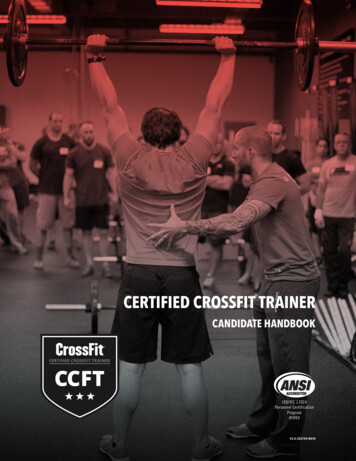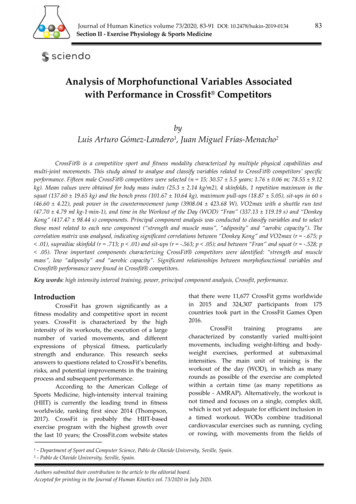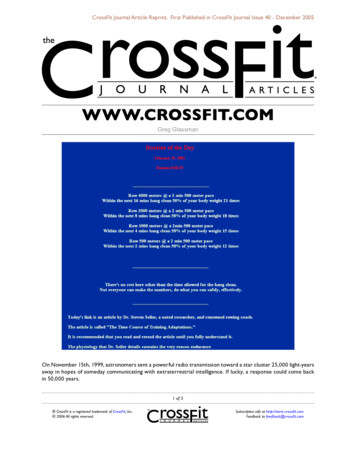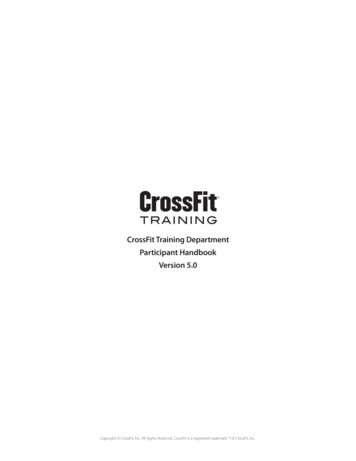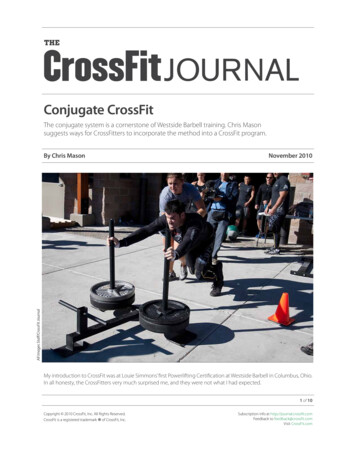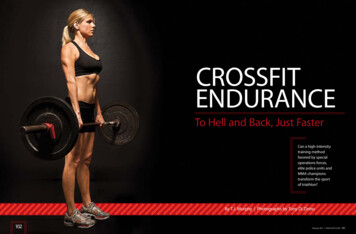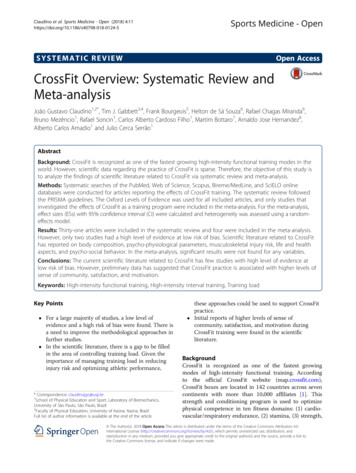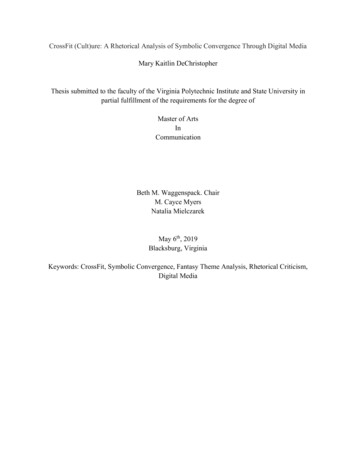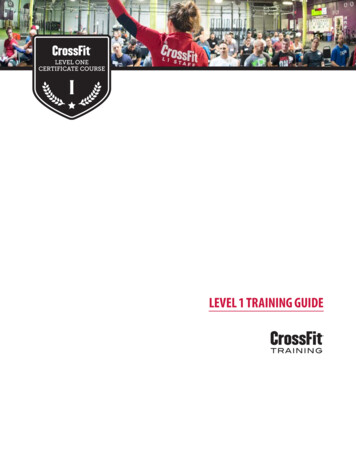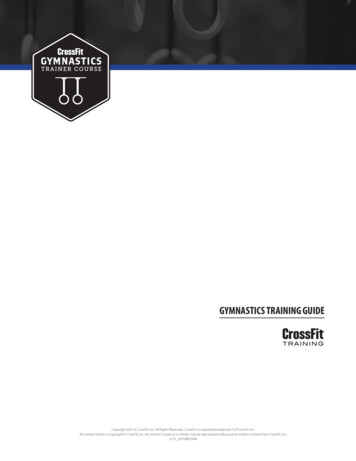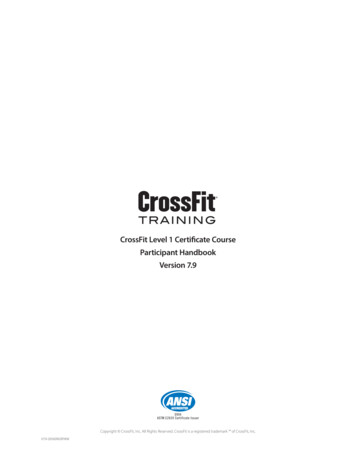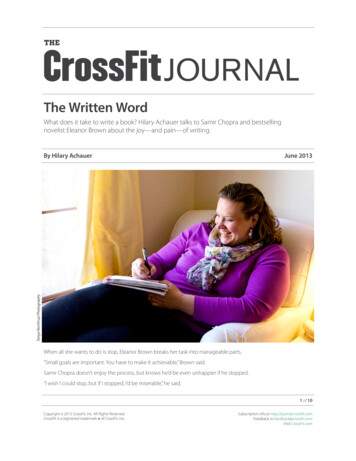
Transcription
THEJOURNALThe Written WordWhat does it take to write a book? Hilary Achauer talks to Samir Chopra and bestsellingnovelist Eleanor Brown about the joy—and pain—of writing.June 2013Tanya Northrup PhotographyBy Hilary AchauerWhen all she wants to do is stop, Eleanor Brown breaks her task into manageable parts.“Small goals are important. You have to make it achievable,” Brown said.Samir Chopra doesn’t enjoy the process, but knows he’d be even unhappier if he stopped.“I wish I could stop, but if I stopped, I’d be miserable,” he said.1 of 10Copyright 2013 CrossFit, Inc. All Rights Reserved.CrossFit is a registered trademark of CrossFit, Inc. Subscription info at http://journal.crossfit.comFeedback to feedback@crossfit.comVisit CrossFit.com
Written Word .(continued)They’re not taking about CrossFit. They’re talking aboutwriting.Brown is a New York Times bestselling author. Chopra haspublished four books. Both are CrossFit athletes.Writers are a strange bunch. Most could never dream ofdoing anything else. They need to write. And yet writersprocrastinate. They drag their heels. They talk about howdifficult it is to face a blank page. At times, they hate writing.Writers are a strange bunch.Most could never dream of doinganything else. They need to write.Tanya Northrup PhotographyIn Bird by Bird: Some Instructions on Writing and Life, AnneLamott puts it this way: “I know some very great writers,writers you love who write beautifully and have madea great deal of money, and not one of them sits downroutinely feeling wildly enthusiastic and confident.”It’s never easy. The journey is filled with detours androadblocks in the form of self-doubt, uncertainty anddistractions.Like most authors, Brown and Chopra have developedtechniques and strategies for being productive, forovercoming obstacles and for getting to the final period.Becoming a WriterBrown at work on her treadmill desk.Through it all, Brown kept writing, but she kept most of herwork to herself.Before she became a full-time, professional author, Brownsaid she did everything else, from working as a weddingcoordinator to taking a job as an executive assistant at aninvestment firm. At one company, Brown’s job was Y2Kcompliance.When she was 25 years old, Brown went to graduateschool and got a master’s degree in English literature. Shesaid it was time to “feed her soul,” but even then she didn’tthink she would ever make a living as a writer.“I worked on the Y2K project,” she said of the late-’90s fearthat the world’s computers would simultaneously crashwhen the calendar changed over from 1999 to 2000. “Istopped it from happening. You can thank me,” she joked.Even though Brown wasn’t a writer with a capital “W,” shewas always writing short stories, articles and what she calls“really terrible novels.”Brown said all the jobs she had in her 20s were greatpreparation for being a writer, but teaching seventh gradeand planning weddings were the most instructive.“There’s a lot of drama in those jobs,” Brown said. “Peopleget drunk and act like idiots (at weddings).”She thought teaching would be it.Brown would devote her summers to long days of writing,and it was during one summer break that her first novelstarted to take shape.“That’s the glorious thing about teaching: the long breaks,”she said.2 of 10Copyright 2013 CrossFit, Inc. All Rights Reserved.CrossFit is a registered trademark of CrossFit, Inc. Subscription info at http://journal.crossfit.comFeedback to feedback@crossfit.comVisit CrossFit.com
Written Word .(continued)This book, which took her about a year to write, eventuallybecame The Weird Sisters. It was published in 2011 toglowing reviews and quickly became a bestseller onseveral lists including that of The New York Times. It tells thetale of three sisters who come from a family heavily influenced by the works of William Shakespeare.“(The book) was much more successful than I thought,”she said. “It put me in a strange position. I have sharedsomething personal. People have expectations.”In December 2011 Brown quit her day job and became afull-time writer.“In both writing and CrossFit, there’s this moment whereI’m in the middle and I think, ‘I can’t finish this,’” Brown said.“It seems like I started a century ago and I have anothercentury to go. But in both cases, it’s really just a matter ofsteeling my resolve and pushing through until the end.Writing and CrossFit both require a certain kind of mentaltoughness and quixotic optimism, a belief that it can bedone, no matter how impossible it looks on the board oron the page.“CrossFit is my reward for hitting my daily word-count goal.It’s also the place I go to work out problems in my writing.CrossFit requires a kind of fundamental focus that is apleasure in contrast to the wide-open potential of writing,”Brown said.Tanya Northrup PhotographyMany people think the life of a writer is filled with dreamydays lounging in front of a computer, either in a book-filledoffice or in the corner of a cozy coffee shop, easily crankingout genius prose. But talk to any professional writer and thewords that most commonly come up are “panic,” “anxiety”and “fear.”This is why Brown finds CrossFit so helpful when she’simmersed in the writing process.CrossFit is Brown’s reward for hitting her daily word count.3 of 10Copyright 2013 CrossFit, Inc. All Rights Reserved.CrossFit is a registered trademark of CrossFit, Inc. Subscription info at http://journal.crossfit.comFeedback to feedback@crossfit.comVisit CrossFit.com
Written Word .(continued)In On Writing, Stephen King’s classic book, King breaksdown the craft. He says that writers not only need to buildtheir own toolbox and fill it with tools for writing—likevocabulary and grammar—but must build up enoughmuscle to carry the toolbox around.“Then, instead of looking at a hard job and gettingdiscouraged, you will perhaps seize the correct tool andget immediately to work,” he wrote.“I believe large numbers of people have at least sometalent as writers and storytellers, and that those talents canbe strengthened and sharpened,” King wrote.Substitute almost anything for “writers and storytellers”in that sentence—athletes, cooks, public speakers—andit still works. The greater the initial talent, the greater thepotential for mastery, of course, but few pick up a tool ofthe trade and find instant success.Ira Glass, host of NPR’s This American Life, said that allaspiring creative types share one thing: good taste. Whena person with good taste starts out attempting to creatework, there’s this awkward phase when he or she recognizes the work is no good.“Your taste is why your work disappoints you,” Glass said.“A lot of people never get past this phase; they quit. Mostpeople I know who do interesting, creative work wentthrough years of this.”Tanya Northrup PhotographyTalk to any professional writerand the words that mostcommonly come up are “panic,”“anxiety” and “fear.”While talent is important, it will get you nowhere withouthard work.To cut down on distractions while she writes, Brown uses an app that blocks the Internet.4 of 10Copyright 2013 CrossFit, Inc. All Rights Reserved.CrossFit is a registered trademark of CrossFit, Inc. Subscription info at http://journal.crossfit.comFeedback to feedback@crossfit.comVisit CrossFit.com
Written Word .(continued)Glass said the only way to close this gap is by sheer volumeof work—building the muscle King talked about.“It’s gonna take awhile. It’s normal to take awhile. You’vejust gotta fight your way through,” Glass said.The RoutineOnce, when she was in the midst of a particularly badpatch, Brown told a friend she didn’t think she could make1,000 words.“My friend said, ‘OK, can you do 500?’ I didn’t think I could,so she said, ‘Can you do five?’”For Brown, the routine is important. Although she and herpartner, author J.C. Hutchins, both work from home in asuburb of Denver, Colo., they go to separate offices in themorning.That day, Brown wrote five words.“I go left, he goes right, and we don’t see each other untillunchtime,” Brown said.“Then two hardest parts of my day are over,” Brown said.“Everything else by comparison seems easy.”After a few hours of writing, Brown heads to CrossFitModig in Highlands Ranch, Colo. She’s done with writingand CrossFit before lunchtime.Brown starts her day writing three pages longhand, witha pen and paper, a technique recommended in The Artist’sWay by Julia Cameron.There are no expectations or goals with these pages.“Sometimes, when I have nothing to say, I just write ‘la la lala la’ for three pages,” Brown said.It’s like a pre-workout warm-up: Brown limbers up andlubricates her creative mind before getting down tobusiness. Once she’s done with her pages, Brown turns onher computer, activating Freedom, an Internet-blockingproductivity software. Then she gets to work, writing mostoften from her treadmill desk.Once she’s done with the writingportion of her day, Brown spendsher afternoon being an author—as opposed to being a writer.“The motion of walking stimulates my brain,” Brown said.She has a regular desk but prefers to write and walk, withthe treadmill set at its lowest speed.Once she’s done with the writing portion of her day, Brownspends her afternoon being an author—as opposed tobeing a writer.“I listen to classical music because I once read that we canonly use different channels in our brain: visual, audio andverbal.”“Neil Gaiman said in a commencement speech, ‘I’m aprofessional email answerer,’” Brown said.Brown feels music with words interrupts the verbalchannel of her brain.Once set up with her music and her treadmill desk, freefrom the distraction of Facebook and Twitter, Brown worksfor two and half to three hours. That’s as much as she canstand.She sets easily achievable goals for each day; in her casethat means 1,000 words a day.“Goals are important,” Brown said. “I could not do 5,000words a day. If I didn’t meet that goal I’d feel like a failure.You do have to be forgiving.”Even her 1,000-words-a-day rule can be changed.She spends her afternoon answering emails, participatingin social media, calling in to book clubs—handling allthe business associated with being a professional authorwhose debut offering became a bestseller.Daily DisciplineSamir Chopra writes nonfiction, but the professor ofphilosophy at Brooklyn College said the writing process isno less painful than writing fiction.Chopra has written or co-written four books: The IndiaPakistan Air War of 1965 (2005, with PVS Jagan Mohan),Decoding Liberation: The Promise of Free and Open SourceSoftware (2007, with Scott Dexter), A Legal Theory forAutonomous Artificial Agents (2011, with Laurence White),and Brave New Pitch: The Evolution of Modern Cricket5 of 10Copyright 2013 CrossFit, Inc. All Rights Reserved.CrossFit is a registered trademark of CrossFit, Inc. Subscription info at http://journal.crossfit.comFeedback to feedback@crossfit.comVisit CrossFit.com
(continued)Courtesy Samir ChopraWritten Word .Chopra writes his blog posts at night, when the house is quiet.(2012). He writes a cricket blog for ESPNcricinfo.com and apersonal blog combining his diverse interests.Chopra is at work on his next academic book, the bulkof which he will write during an upcoming teachingsabbatical. Chopra has tried writing in the library and incoffee shops, but he prefers to write at home.“I like my keyboard,” he said, “I don’t like writing on a laptop.”Now that Chopra and his wife have a baby at home, beingproductive is much more difficult—especially because hisdesk is in the corner of the main living space.recognizes he might need to arrange for childcare as hisdeadline approaches.In order to make progress,Chopra practices what he calls“Internet fasting.”“Just being at home is distracting,” he said.Making things even more difficult, Chopra will be takingcare of the baby when his wife goes back to work in afew months. He plans to work while the baby naps butIn order to make progress, Chopra practices what he calls“Internet fasting.” It’s a self-imposed version of the Freedom6 of 10Copyright 2013 CrossFit, Inc. All Rights Reserved.CrossFit is a registered trademark of CrossFit, Inc. Subscription info at http://journal.crossfit.comFeedback to feedback@crossfit.comVisit CrossFit.com
Written Word .(continued)software Brown uses. Chopra gets up, pours himself somecoffee and doesn’t so much as check his email until he’swritten for an hour.“It makes me unhappy how addicted I am (to the Internet),”he said.Chopra said the most important thing for him is justgetting in front of the computer with his hands on thekeyboard.“It’s like the famous Roger Ebert quote: ‘The muse onlyvisits while you work,’” he said.Like Brown, Chopra finds it’s best if he keeps his daily goalsmodest.“I just write for one hour. I set my sights low.”Chopra’s blogs add to his workload, but just as working outfrequently makes a person stronger, he believes the dailypractice of writing ultimately makes him more productive.“When I’m blogging I’m using my writing brain,” Choprasaid. “I have to think of ways of making a critical point andmaking people think.”He said his writing disciplines—blogging and bookwriting—feed back into each other.Chopra’s first book was inspired by his father, who wasin the air force during the India-Pakistan air war of 1965.Chopra’s dad died when Chopra was 12 years old, and thebook was an effort to engage in what he calls “personalarcheology.”His co-author on The India-Pakistan Air War of 1965 “hada website dedicated to this topic. I told him, ‘Maybe I canhelp you,’” Chopra said. The two collaborated long distance,sending each other drafts and editing each other’s work.“We did not meet until the book was finished,” Chopra said.Next, Chopra wrote about the relationship between opensource software and freedom, as well as about legal theoryfor autonomous artificial intelligence. His most recentbook, A Brave New Pitch, is about the evolution of the sportof cricket.“A deadline and the expectations of a co-author forced meto get moving,” Chopra said of these projects.He says another key to his success has been CrossFit, whichhe started in 2009 at CrossFit South Brooklyn. He wasburnt out from the regular gym scene and decided to giveCrossFit a shot. He’s been going consistently ever since.“(CrossFit) helps impose a structure in my daily life,” Choprasaid. “I have to get out of my house and work out for anhour.”Chopra said the values of patience and humility he hasdeveloped in his almost four years of doing CrossFit havehelped as he works through difficult ideas and concepts.“The steadfast application of the life of the mind is helpedby the pursuit of CrossFit,” he said.Asta FivgasOlympic lifting, in particular, has made him more patientwith incremental progress.“I’ve heard it takes 2,000 to 3,000 reps to get a clean right,”he said. “I’m still working on that.”Chopra trades typing for tires in Brooklyn, N.Y.7 of 10Copyright 2013 CrossFit, Inc. All Rights Reserved.CrossFit is a registered trademark of CrossFit, Inc. Subscription info at http://journal.crossfit.comFeedback to feedback@crossfit.comVisit CrossFit.com
(continued)Asta FivgasWritten Word .Chopra reflects on his squat, and perhaps his next blog post.InspirationSo let’s say you carve out a time to write, manage to ignorethe easy distractions of the Internet and sit down at thecomputer only to find you have no ideas. The infinite possibilities of the blank page are mocked by the flashing cursor.Where do writers get all their ideas, anyway?“Inspiration can come from anywhere,” Brown explained. “Iwas looking at a gossip magazine, and I saw a photo ofJennifer Aniston and her realtor.”Brown began to wonder about that relationship. What wasit like? She hasn’t turned this idea into a book yet, but it’s anexample of the kind of thing that starts her wheels turning.Some concepts that fascinate her are what it means to bea grown-up, and why, when we’re around our siblings, dowe act like we’re 12 years old?“It doesn’t ever get easier.The only way out is through.”—Samir ChopraBrown finds that some of the same issues are coming upin her latest book.“It’s a belated coming of age,” Brown said. “Some of theissues are: do you control your own fate?”Ideas also come from reading, and most authors areunapologetic bookworms.“Every writer writes about the things they wonder about,the things that are eating at them,” Brown said.“Being a good writer begins with being a good reader,”Chopra said.8 of 10Copyright 2013 CrossFit, Inc. All Rights Reserved.CrossFit is a registered trademark of CrossFit, Inc. Subscription info at http://journal.crossfit.comFeedback to feedback@crossfit.comVisit CrossFit.com
Written Word .(continued)Brown agrees, and she feels being a reader is essential ifyou want to be a writer.“Any sort of writing is a conversation,” Brown said. “Youcannot be a part of the conversation if you aren’t listening.”Both authors agree that reading is essential, but it mustbe combined with putting words on paper. At some pointyou have to stop reading and start writing, no matter howpainful it might be.“Talent doesn’t hurt, but the worldis full of talented people who nevermade anything happen.”—Eleanor Brown“Talent doesn’t hurt, but the world is full of talented peoplewho never made anything happen,” Brown said. She saidit’s all about practice and habit.Chopra agrees that there are no detours; you simply haveto write.“It doesn’t ever get easier,” Chopra said. “The only way outis through.”Open-Door EditingProcess aside, both types of writers have to put somethingon the page, and fear of failure, of producing bad work,stymies some would-be writers. Many successful writersknow just getting words on the page is the first step, evenif what they write is messy, even embarrassing. It’s a firstdraft. To possess the audacity to get words on a page, theusual standards have to be momentarily put aside, at leastfor the “swoopers.” For the “bashers,” those standards mustbe met—perhaps after repeated bouts of self-censorshipAsta FivgasIn Timequake, Kurt Vonnegut wrote about two kinds ofwriters: “Swoopers write a story quickly, higgledy-piggledy,crinkum-crankum, any which way. Then they go over itagain painstakingly, fixing everything that is just plainawful or doesn’t work. Bashers go one sentence at a time,getting it exactly right before they go on to the next one.When they’re done they’re done.”“It doesn’t ever get easier. The only way out is through.”—Samir Chopraand self-editing—before a word gets onto the page. Forthem the revisions happen internally, and the editors areoften vicious with the red pen.King puts it succinctly in On Writing: “Write with the doorclosed, rewrite with the door open.”What this means is that the first draft is for the writer’s eyesonly. Those words provide a foundation upon which thewriter can build. Many times it’s an invisible foundation—as nothing remains from the first draft in later versions—but plans for the support structure are still there.9 of 10Copyright 2013 CrossFit, Inc. All Rights Reserved.CrossFit is a registered trademark of CrossFit, Inc. Subscription info at http://journal.crossfit.comFeedback to feedback@crossfit.comVisit CrossFit.com
Written Word .(continued)most trusted resource,” Brown said. “He is the person I wantto read (my work) first.”Asta FivgasHutchins, Brown’s boyfriend, is skilled at writing compellingplots and is best known for his 7th Son series, published inprint and podcast. Brown said she’s more into characterdevelopment.In fact, when her editor bought The Weird Sisters, the editor’sfeedback to Brown was, “You have written a beautiful book.Something needs to happen in it.”Like a good CrossFit coach improves movement, an editorhelps a writer fine-tune his or her words.Once the first draft is done, then comes the exhaustive(and exhausting) revision process.Chopra says he enjoys the initial editing process, which hesays is a relief from the “utter panic” of the writing stage.“My writing process remains the same as it ever has: I makea lot of notes and then I work them into shape. I have neverworked with outlines. This has always meant that the intermediate stage of my writing—from notes to a draft—is acutelyanxiety-and-panic provoking,” Chopra wrote on his blog.It’s in this initial editing stage that the writer often discoversthe value of what he or she has created. Revisiting one’sown work can sometimes hold pleasant surprises. It’s herethe author discovers the work isn’t terrible but might evenbe good.It’s not unlike drilling the parts of the snatch—the pull, theshrug, the reception, etc.—for months on end and thenone day finding it all comes together. The previously heavybar soars overhead and the lift is completed.Once the work has been shaped into a draft that mightactually make sense to another person, it’s time to getsomeone else’s opinion.This can be an extremely nerve-wracking experience,especially for an author who has poured his or her soulonto the page, and many writers rely on a trusted readerwho offers feedback in the early stages of the writingprocess.Brown said she’s tried out writer’s groups and writingclasses and found them helpful when she was starting out.Now, she writes on her own, relying on her boyfriend asher trusted first reader.“My boyfriend is a writer, and he is my first reader. He’s myFor Chopra’s blog posts, his trusted reader is his wife. Hesays it’s a bit more challenging to find people to readhis academic books, because the subject matter is fairlyesoteric.“You want someone who is sympathetic and critical,”Chopra said.The final editing stages are just as agonizing as the initialstages, he says.“You are just so sick of your work,” he said. “’I have read thisfucking book 20 times,’ you think. ‘I just want to be donewith it.’”At present, Brown is deep in the editing stage of hersecond novel. She said it took a year to write and just aslong to edit. Her first effort was such a success—more thanshe ever imagined—and now Brown feels the pressure forher second novel to be just as successful.“You want something you are proud of,” Brown said of whyshe’s taking so long to revise her current project.“Being an artist, you have to have incredible optimism inyour own work and an ability to be objective and honestwith yourself,” Brown said.“Failure is where we learn. All those projects in a drawer, Ilearned something,” she said. “A successful artist will look atthose failures and figure out how not to repeat them.”FAbout the AuthorHilary Achauer is an award-winning freelance writer andeditor specializing in health and wellness content. In additionto writing articles, online content, blogs and newsletters, Hilaryis an editor and writer for the CrossFit Journal and contributesto the CrossFit Games site. An amateur boxer-turned-CrossFitathlete, Hilary lives in San Diego with her husband and twosmall children and trains at CrossFit Pacific Beach. To contacther, visit hilaryachauer.com.10 of 10Copyright 2013 CrossFit, Inc. All Rights Reserved.CrossFit is a registered trademark of CrossFit, Inc. Subscription info at http://journal.crossfit.comFeedback to feedback@crossfit.comVisit CrossFit.com
was always writing short stories, articles and what she calls "really terrible novels." Brown would devote her summers to long days of writing, and it was during one summer break that her first novel started to take shape. "That's the glorious thing about teaching: the long breaks," she said. Writers are a strange bunch.
